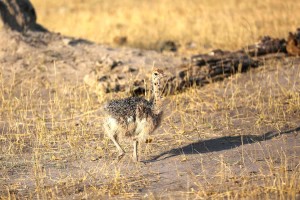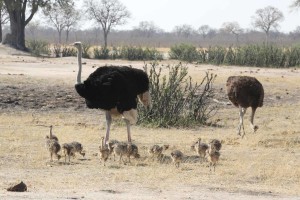
Image Dave Dell

Image Dave Dell

Image Dave Dell
The flightless ostrich is native to Africa and is the world’s largest bird. Its average lifespan in the wild is 30 to 40 years. It lives in savanna and desert, and weighs up to 155kg. Ostriches are the fastest runners of any 2-legged animal, and can sprint up to 70km/hour. Adult ostriches have a wingspan of about 2 meters; the wings are used in mating displays, to shade the chicks, and to cover the naked skin of the upper legs and flanks to conserve heat. When threatened, ostriches run, but their powerful legs can be used as formidable weapons and can kill potential predators with a fearsome forward kick, the long toes on the foot are used to rip open the unfortunate victim.
Ostriches spend the winter months alone or in pairs but during the breeding season may live in flocks of 5-50 birds, usually one male with his harem of females that he vigorously defends. A complex mating ritual is performed. The cock beats his wings until he attracts a mate. He drives away all intruders, then violently flaps his wings and winds his head in a spiral, snaking motion while the hen circles round him with lowered wings. This performance will go on until she eventually drops to the ground and the male mounts her.
All of the herd’s hens place their giant eggs in the dominant hen’s nest, though her own are given prominent center place. The dominant female incubates the eggs by day, and the male takes over at night using the colouration of the two sexes to escape detection of the nest. The drab female blends in with the sand, while the black male is nearly invisible in the dark. When the eggs hatch after 35-45 days, the male usually defends the hatchlings and teaches them to feed, although males and females cooperate in rearing the chicks.

Image Dave Dell
The wild ostrich population has declined drastically in the last 200 years with most surviving birds now found in game parks and on farms. Predation of eggs and chicks is very high; only 10% of nests survive incubation and 15% of chicks survive to 12 months of age.

Image Dave Dell
Ostriches are omnivorous. Lacking teeth, they swallow pebbles to help grind up their food. They can go without water for several days as they utilize metabolic water and moisture in ingested roots, seeds and insects; but they enjoy a drink and frequently take baths when water is available. Ostriches have the largest eye of any land animal, measuring almost 5cm across which allows predators to be seen at long distances.